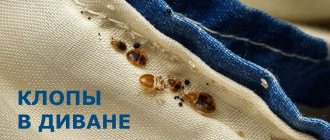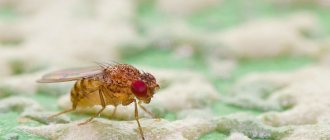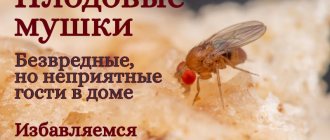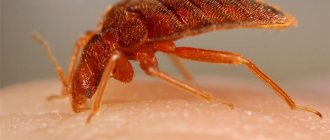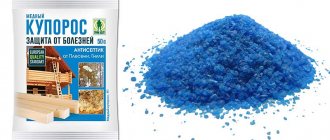Fruit flies are a common sight in the kitchen; they multiply quickly, speed up food spoilage, and cause irritation. In order to figure out how to get rid of fruit flies in an apartment, it is necessary to determine the causes and source of their appearance, eliminate it and disinfect the room.
Drosophila are small midges that grow in apartments with poor hygienic conditions. They multiply quickly, causing serious inconvenience
The article contains popular and effective methods of pest control: folk remedies, chemicals, special repellers and homemade traps.
Fruit flies and how to get rid of them
Drosophila melanogaster, also known as the fruit fly or vinegar fly, is a small, about 3 mm in length, insect of the Drosophiliadae family from the order Diptera. These flies can be observed near spoiled fruits. In nature, they also feed on plant sap and rotting plant debris. The larvae also feed on microorganisms. Drosophila (we call it “wine fly”) follows the smell of wine.
One way or another, everyone has encountered fruit flies. You should forget about vegetables or fruits that are stored outside the refrigerator, overwater indoor plants - they are right there. This time we got it when we put in apple cider vinegar. It's difficult to get rid of. Therefore, we are making a separate article - we are studying who they are and how to get rid of them without using chemicals.
Fruit flies (lat. Drosophilidae) are a family of the order of dipterous insects (Diptera), including more than 2000 species. It has a worldwide distribution. The most famous genus is Drosophila. Representatives of this genus are also called fruit flies.
The family includes two subfamilies - Drosophilinae and Steganinae - and about 70 genera. The larvae develop in decaying plant debris, fruits, vegetables, and mushrooms.
The easiest way to get rid of fruit flies within a few days is to completely deprive them of food. But here it is difficult to do this - in a village house, in the kitchen, there is always something for them. You can hang adhesive tape - it helps, but not much.
Young larvae cannot penetrate deep into the solid medium and die, while eggs laid in a liquid medium may die.
They say that fruit flies can also eat thermal insulation. True, this is unverified information, but rumors. However, I met them several times. Whether this is true or not, I don’t know.
The fruit fly, Drosophila melanogaster, is known to many aquarists. Both adult insects and their larvae are used as food.
Drosophila flies: who are they and what are they?
Drosophila fly or fruit fly
Drosophila flies are fruit flies that are small in size - no more than 3 mm. They live only 2 months, but they multiply quickly: one female can lay more than 2000 eggs! For this reason, getting rid of these insects is not so easy. Within 10 days the larva matures into an adult.
Drosophila flies are heat-loving creatures; they are more common in southern cities rather than northern ones. Insects do not bite people or animals. But they are annoying because they constantly flicker before our eyes, multiply quickly and live in food.
Such midges can make up to 250 wing beats per second - according to this indicator, they are ahead of all other types of insects. At the same time, the human ear can catch the noise of their flight, since the wings of midges have a special shape.
Females and males of Drosophila. Reproduction
The Drosophila fly, like all dipterans, has three stages of development: egg, larva, and adult insect.
Morphologically, females and males differ from each other in a number of characteristics. Females are somewhat larger than males, although the size of both can vary greatly depending on feeding conditions, especially the larval period of development.
The female's abdomen is somewhat rounded, with a pointed end; in the male it is cylindrical, with a blunt end. Also, the male can be easily distinguished from the female by the last few segments, which are completely pigmented. The upper chitinous scutes of the chest in insects are called tergites (they, together with the sternites and pleurites, participate in the movement of the wings).
The female has eight well-developed tergites, and the male has six, with the sixth and eighth tergites fused, and the eighth included in the reproductive apparatus. The sternites are the same chitinous plates on the ventral side. The female also has one more of them than the male, and in representatives of each sex the first, second, seventh and eighth sternites are not developed.
Drosophila eggs are somewhat elongated, about 0.5 mm in length. In fresh cultures they are easily noticeable, being deposited on the nutrient medium.
The hatching of the larva from the egg and the beginning of postembryonic development is associated with increased nutrition and growth. Excess food at this stage of an individual’s life is of great importance: to a large extent it determines not only the size of the fly, but also its viability. The first time after hatching, the larvae remain on the surface of the medium. Then they go deep into it and remain there until the moment of pupation.
Pupation begins with the larvae leaving the environment, stopping feeding and crawling briskly for some time. Then they become motionless, significantly shorten in length and acquire the barrel-shaped shape characteristic of a pupa.
The pupal period of development is characterized, on the one hand, by the destruction of larval organs and tissues, with the exception of the gonads and nervous system, and on the other, by the development of the definitive organs of the adult fly from the imaginal discs. The period of puppet transformation is 4 days.
At the end of the third day, the outlines of the eyes become visible through the cover of the pupa, in which by that time a yellowish pigment is produced. A few hours before hatching, the wings are clearly visible, and by this time the eyes become bright red.
Hatching of the fly and its release from the pupa cover is achieved by pumping liquid, as a result of which the pupa shell ruptures and the fly is released.
Flies usually emerge from their pupa early in the morning. Young, newly hatched flies have a long yellowish body, almost devoid of pigment, and short, not yet straightened wings. After 8 hours, the females are ready for fertilization. Females begin laying eggs from the end of the second day and continue until the end of their lives.
Where do they come from?
“What kind of fruit flies are they and where do they come from?” is a common question on thematic forums. Many people have the impression that these midges literally materialize out of thin air. Some people confuse them with soil ones, but they belong to a different species and live on window sills in wet flower substrate.
The main source of fruit fly infestation is vegetables, fruits, and berries brought home.
The Drosophila egg is only 0.5 mm long. The female lays from 50 to 80 eggs at a time. With one apple or plum you can quietly bring a flock of midges.
They will hatch in 8-15 days. They live no more than 20 days, but during this time the female will have time to lay up to 400 eggs.
Other options for where midges come from on fruit in an apartment:
- ventilation shafts;
- open windows, doors;
- Pets.
Theoretically, eggs can even be carried on shoes.
Another source of fruit flies is rotting houseplants. Decaying pulp attracts fruit flies as a favorable nutrient medium.
This happens especially often with cacti. Externally, the plant often looks normal, but putrefactive processes are already underway inside.
Midge traps
Glass jar
- Place bait (pieces of fruit, juice or compote) in a glass jar.
- Make a funnel out of paper.
- Make a small hole at the tip of the funnel.
- Insert the funnel into the neck of the jar, tip down. Tape the joint area with tape.
The midges fly to the smell of the bait, end up in the jar, and it’s difficult to get out because the bottom hole of the funnel is small and difficult to find.
A plastic cup
- Take a small plastic disposable cup (you can use one for yogurt, etc.).
- We place bait for midges in a glass: pieces of fruit (apple, peach, nectarine, banana), juice, compote, used tea bag, etc.
- We stretch cling film over the top of the glass.
- We make small holes in the film with a thick needle (the size of the hole should be such that the midge can climb in, but not too big, otherwise it will crawl out back).
- We put the glass where midges often live.
The midges follow the smell, get into the glass, but can’t get out because the holes are small. When the number of midges reaches about 15 pieces, you need to throw the glass in the trash. Repeat the procedure until all the midges are eliminated.
Plastic bag
Place several apple cores in a plastic bag for a day, preferably sour ones. Midges love sour and spoiled things. They will climb into the bag and begin to live there and feed. When they are in a bag, you need to carefully and quickly tie the bag. And throw it away.
Prevention of Drosophila
You need to wash the trash can and do some general cleaning in the kitchen. Remove all leftover food. If you have pets, clean out their bowls regularly, and if they leave food behind, clean out the refrigerator. Don't leave dirty dishes behind. Check bags of vegetables regularly and throw away any that are rotten.
You need to find their “home” - usually it is soggy potatoes, “brooding” or rotten vegetables and fruits. If fruit flies have nothing to eat and nowhere to reproduce, they will gradually disappear on their own, and there is no need to breed them with all sorts of dichlorvos and raptors. You need to remove all food, take out the trash, and do not water indoor plants (if any).
Check under the sink - food debris can remain there and become a breeding ground. They can start in a pumpkin that lies on the closet, or in an onion. Often grown in flower pots of indoor plants. Sometimes they fly into ground coffee. They are diluted in a teapot if you do not throw away the tea leaves.
Preventive measures
It’s not difficult to prevent the appearance of fruit flies in your apartment; all you need to do is:
- keep clean;
- regularly (at least once a day) take out the bucket;
- wash dishes immediately after a meal;
- Throw away spoiled fruits immediately;
- Do not leave food in your pet’s bowl for a long time, remove it as soon as the animal eats.
If the midges have nothing to eat, they will not appear in the apartment.
Even if midges have infested your apartment, you should not immediately rush to the store for chemicals - you can get rid of them using traditional methods, without the use of toxic substances.
Useful tips - how to get rid of midges
We take these tips from the comments under the article on the site - many of the tips are original and very interesting! So:
- If a midge starts in flower pots, then you need to stick an ordinary match there, head down, they disappear.
- Most often, flies appear due to rotten potatoes, onions - all spoiled root crops are a breeding ground for flies. The main thing is to remove the source. Gradually they will disappear. Be patient.
- Once a week I do a total cleaning with ultraviolet light, and for a year I have had an ultrasonic trap running, and this is how we save ourselves.
- I solved the problem with flies simply: 1) I collected crawling and flying ones with a hand-held kitchen vacuum cleaner (fortunately they don’t fly fast). 2) at night in the place where they accumulate (for me it’s a jar of kombucha) I turned on a mosquito lamp. The effect is amazing - in the morning there are almost no flies!
- They can be caught perfectly with a vacuum cleaner, even on the fly!
- The jar of flies can be placed in the freezer for a few minutes. They'll die. Verified.
- I poured beer into the lid of the cake so that it barely covered the bottom, a lot of it collected and almost everyone drowned.
- I have found that they really like spoiled bananas. In the kitchen I put a crushed, rotten banana in a bag. Problem solved.
- Adhesive fly tape, spread with red wine. And here they are right there.
My husband accidentally left the remnants of apple compote in a jar on the table, during the night they filled with darkness, at first I covered them with a plastic lid and then thought for a long time about how to kill them, I can’t open them, throwing the jar away in this form is also not a good idea, I decided to put it in the microwave and turned it on for a minute!
The end came to them all instantly! The glass jar needs to be placed in the microwave, covered with a plastic lid, don’t be afraid, it won’t explode, 40 seconds at a power of 600 - 700 is enough.
Tip: pour part of the water, part of the apple cider vinegar or juice and a little dishwashing detergent into a glass jar and put this jar where you have the most flies, and in a few hours you will have almost no flies, they are attracted to this trap .
Apple cider vinegar attracts flies and they fly into this jar; dishwashing detergent prevents them from getting out. This fluid needs to be renewed once a week.
Getting rid of fruit flies is very easy. Buy fly or mosquito repellent plates that are designed for raptors. Install the plates to the window glass and the problem is solved! The sun heats up the plate and releases a deadly poison for flies.
I accidentally discovered a remedy for fighting flies: I started peeling horseradish roots for a horseradish snack, left the horseradish peelings in an open bag - all the flies instantly disappeared. Several days have passed and they have not returned.
Description of the insect
The fruit fly is also called a fruit fly or a wine fly. Her favorite habitat is around spoiled fruits and sweets. The insect lives off plant juices and rotting residues, which often appear in the kitchen in the summer.
Fruit flies mainly appear on fruits in the summer.
Drosophila larvae and adults also like to live where it is warm. As soon as cool weather sets in, the adult colony dies, leaving behind millions of larvae. The new future population successfully survives the unfavorable period, only to be reborn in a noisy swarm with the onset of warmer weather. Therefore, even if you got rid of adult insects, it is worth maintaining the proper level of cleanliness and hygiene in the kitchen so that insect colonies do not re-emerge.
Flies will leave behind larvae, which, under favorable conditions, are reborn.
Fruit fly traps
There are also ready-made products on sale to get rid of fruit flies, and they are effective. If you use homemade vinegar, place traps right next to it, otherwise the flies will scatter throughout the house.
The Raptor glue trap with bait liquid will provide effective protection against fruit flies. The principle of operation of the trap is simple. The liquid contains a special substance that attracts flies. Following the smell, insects end up on the sticky surface on the inside of the trap without the ability to get out of it again. At the same time, the trap remains clean and attractive in appearance. A feeling of comfort and cleanliness in your kitchen is guaranteed!
Directions for use: Open the box. Take out a can of liquid. Unscrew the cap of the can. Take out the cardboard tape with the sticky layer. With a sharp movement, remove the protective paper from the adhesive layer.
Fold the trap in the form of a “house” with the sticky side with the printed pattern inside, connecting the lock with the inscription “insert into grooves” in the direction of the arrows. Place the trap on the neck of the can. Make sure the perforation on the trap fits snugly around the neck of the can. Place the trap in places where insects grow - in kitchens near fruit and in pantries - cabinets for storing food - potatoes, onions, etc. Do not place in drafts. The trap retains its ability to attract flies for up to 30 days. Consumption rate – 1 trap per room of 10-12 m2.
And one more trap: Aeroxon trap for fruit flies. It is structured in approximately the same way, only here there are 2 pieces in the package. The flies begin to fly in very quickly - excellent cleaning of the room!
The Aeroxon glue trap is designed to kill tiny flies flying over rotting fruit. Fruit flies are found in kitchens, utility rooms and warehouses where fruits and vegetables are stored. The flies are lured with a special bait onto the adhesive surface of the trap and are firmly glued to it. The trap can be placed in close proximity to food products; it is completely safe.
Source: hnh.ru/food/2010-09-19-1
Fighting flies at home with folk remedies
Tomato tops - a means to repel small flies
Drosophila are attracted to rotting leaves and damp substrate, so they often hover near pots with indoor plants. Insects can also be caused by contaminated soil. To prevent them from multiplying, it is necessary to calcine the soil in the oven. It is recommended to promptly remove rotten and fallen leaves and not to pour water into the ground.
Four ways to deal with fruit flies:
- Small insects cannot stand the pungent smell of tomato tops. To get rid of fruit flies, you can grow seedlings on window sills.
- Camphor is an effective remedy for small flies, since they cannot tolerate the smell of this product. To kill annoying flies, you need to pour camphor into a frying pan and heat it on the stove to maximum temperature until steam forms. Next, walk with it throughout the house so that the aroma spreads throughout all the rooms.
- Essential oils of basil, anise, and eucalyptus can repel fruit flies. To scent a room of 15 m², the product consumption will be 5 drops.
- At the dacha near the house, you can plant myrtle, eucalyptus, tansy or geranium to repel pests.
Fruit flies: how to quickly get rid of annoying insects
Once fruit flies appear in your kitchen, they will not leave. And, what good, they will also multiply. You can’t do this without special tools—some of them are stored in your home.
Small fruit flies, attracted by the smell of rotting fruit, garbage and forgotten food, settle in the apartment for a long time, refusing to voluntarily leave the nourishing place. They are quite harmless - at least they do not bite humans or domestic animals. But they multiply at tremendous speed.
Just imagine: a female Drosophila can lay up to 500 eggs, and within 24 hours the first larvae are born! So, if you notice a swarm of small brown flies in the kitchen, don’t hesitate: sort through the food (flies are attracted to darkened bananas and rotting fruits and vegetables), throw out the trash, clean up the kitchen and start eliminating annoying insects - with the help of these simple household funds.
An unusual option for fighting is predator plants
Plants that feed on small flies, mosquitoes and other insects. They do not require special care, tolerate unfavorable conditions well and do not take up much living space, but, nevertheless, they fight flies well.
In conclusion, it is worth noting that the reproduction of flies occurs quite quickly, which is why they are extremely popular among biologists. They are an ideal object for conducting many experiments. The genetic code of these insects has many similarities with humans. Thanks to this, scientists have the opportunity to develop new means of combating cancer and hereditary diseases. To a greater extent, fruit flies are not pests; they process waste and enhance decomposition processes, returning minerals and oxygen to the cycle of substances, but, nevertheless, they extremely poison human life. When used in combination, the remedies proposed in this article will help make life easier and get rid of annoying fruit flies.
Vinegar
Unfiltered apple cider vinegar is considered the best weapon in the fight against fruit flies. You can buy it at an organic grocery store or make it yourself.
Pour a small amount of liquid into a glass, cover it with a layer of cling film and secure it with a rubber band. Using a sharp pencil, make several holes in the “lid”.
The sweet smell of apple cider vinegar will definitely attract insects. Once they get inside the glass through the tiny holes, they will not be able to get back out.
Note: Add a small amount of dishwashing liquid to the vinegar. It will give it viscosity - stuck flies will definitely not be able to get out of the trap and will soon die.
Drosophila in the apartment
Fruit flies have wings, but they fly rather poorly. The maximum distance that this fly can cover is about 180 m. Therefore, they cannot fly from afar. So where do fruit flies come from? Initially, they live in nature, usually in gardens with fruit trees.
In addition, if you take soil from the street to plant indoor plants, you risk bringing the larvae of these insects into the house, which will hatch in the apartment.
Sometimes fruit flies still fly into apartments through windows and ventilation ducts. Before this, they can swarm in the dump near the house and in the trees. At the same time, these flies populate not only the kitchen. They will appreciate your indoor flowers, in the trays of which the water has stagnated and turned sour, as well as containers with pet food, where Drosophila can not only feed, but also successfully reproduce.
These flies are not capable of harming humans. They do not bite and do not transmit diseases. But at the same time, these insects, with their annoying flickering, cause some discomfort.
Lemon
Fruit flies are attracted to sour smells. If you have a lemon on hand, use it to catch insects. Trim the edges of the fruit so that it can be placed horizontally when cut.
Take a plastic or glass container with a lid. Squeeze a little lemon juice into it, and place the citrus itself on top. Make a small hole in the lid of the container - large enough so that the fly can easily crawl through it, but small enough so that it cannot find its way back.
Close the container and place it in a place where there is a high concentration of insects. Once there are enough fruit flies inside the trap, pour water into it (through the hole in the lid) and place it in the microwave for 15-30 seconds.
Red wine
These fruit flies are such gourmets - they love to pamper themselves with fruit, and they will not refuse red wine. If you have some left at the bottom of the bottle, use it to fight off pesky insects. Place the open bottle in the area where the largest number of flies have accumulated and wait a little.
The smell of wine for fruit flies is like an exquisite aroma of perfume. Once they feel it, they will immediately head inside the bottle. And all you have to do is close it in time and throw it in the trash.
Paper funnel
Place a piece of rotten fruit or a banana peel soaked in beer at the bottom of a glass jar (alcohol attracts flies no less than the aroma of fruit). Make a funnel out of carbon paper and place it in the container with the sharp edge facing down.
This is the simplest version of a fruit fly trap. Attracted by the pleasant smell, they will get inside the jar and will not be able to get back out.
Source: goodhouse.ru/home/najdi-vremja-dlja-zhizni/plodovye-mushki-kak-bystro-izbavitsya-ot-nadoedlivyh-nasekomyh/
How to get rid of midges in the kitchen in 3 steps
These small midges themselves do not pose a threat to humans, but a larva accidentally swallowed with food can cause infection of the digestive tract. The fertility of fruit flies is extremely high: one female produces from 200 to 1,500 or more eggs. Insects can live in the kitchen for two months, which means the risk of developing myiasis increases.
Drosophila eggs can enter the home on the fur of cats and dogs, in food, or on shoes. The food supply of midges is rotting organic matter.
This could be rotten fruit, an unfinished glass of wine, spilled milk, waste lying in the trash can, a piece of meat that fell into a crevice while cooking, or damp soil from indoor plants. The list can be expanded endlessly. Midges even feast on pet food.
Characteristic
Drosophila is a fruit fly, which is a representative of a genus of small insects from the fruit fly family. In total, there are about 1.5 thousand described species, and most of them are synanthropic, that is, their way of life is closely related to man and his home. In houses and apartments there are conditions that are most favorable for the normal life of fruit flies, in particular, an inexhaustible source of food. In nature, these insects feed mainly on plant juices and rotting organic matter. And the diet of their larvae also consists of microorganisms.
In our apartments, the most common drosophila is the common drosophila, a small fly with red eyes and a yellow-brown body color. Females are larger than males - about 2.5 mm, and at the same time, the tip of the abdomen is colored black in the latter. Females have dark transverse stripes on this part of the body.
Females lay eggs in rotting fruit, from which larvae emerge 24 hours later. Those, in turn, after 5 days turn into pupae and after another 5 days, adults emerge from the pupae.
The Drosophila fly does not live long - about 2 months, but since reproduction occurs quite rapidly, in a short period of time they are able to populate almost the entire apartment.
How to get rid of midges
Step 1. Conduct an audit
The main enemy of kitchen midges is the most ordinary hygiene, which deprives them of food. Therefore, when fruit flies appear, first check the inside of the kitchen:
- Sort through the potatoes, onions, and carrots stored for the winter. Throw away or recycle rotten vegetables. Do this regularly.
- Place separate containers for bulk products to prevent moisture from getting into them. While pouring, carefully check the grains for the presence of fruit fly larvae.
- Place all spoilage foods in the refrigerator. Try to fill the vase with fruit as it becomes empty, rather than later.
- Wash the bread bin thoroughly and dry. Only after that put bread in it.
- If there are plants in the kitchen, loosen the soil, remove fallen leaves, thoroughly wipe the outside of the pots and wash the tray with cleaning product. If there are midges in flower pots, change the soil to new one, and irrigate the leaves of the plants with a weak solution of potassium permanganate.
- Take out the trash and wash the bucket several times with a strong disinfectant.
- If you have pets, regularly change the water in the drinking bowl and make it a rule to put leftover food in the refrigerator or a specially designated container.
- Check the cleanliness of the refrigerator. Be sure to tidy it up if there are any smudges, old food debris, or moldy food.
Step 2: Do some spring cleaning
It is very important to thoroughly clean all kitchen surfaces. The breeding ground for midges may suddenly appear in some crack where, for example, a piece of an apple accidentally fell.
- Wash the stove thoroughly, especially its side walls. The oven can be quickly cleaned with steam. Place a baking tray with water diluted with dishwashing detergent inside. Preheat the oven to 100°C and leave for 30 minutes. Now the grease and burnt marks can be easily removed with a damp cloth.
- Be sure to check your microwave. To get rid of stubborn fat, use a mixture of 500 ml of water and 1 tablespoon of citric acid (or 4 tablespoons of lemon juice). Heat the resulting solution in the microwave for 5–10 minutes at maximum power, then let the device cool for 5 minutes and wipe the surface with a sponge.
- Thoroughly clean all hard-to-reach places with a brush and wash the floors. Pay special attention to the compartment under the sink.
- One of the breeding places for midges is the sink drain, where small pieces of organic matter often get stuck. To clean the drain, you can use any pipe cleaner or a traditional recipe. Pour a few teaspoons of baking soda into the hole, pour in a glass of vinegar and wait 20 minutes. Then rinse with hot water.
Chemical control methods
"Dichlorvos". The most obvious remedy and you should not be skeptical about it. Over the many years of its existence, it has undergone a number of improvements and is practically odorless. In addition to it, there are similar products with other names. Spray the area thoroughly with the product and leave for half an hour. During this time, fruit flies will be exterminated and substances harmful to humans will have time to be neutralized in the room.
If a person is allergic to the chemical components of the same “Dichlorvos” or does not want to use ready-made products, but does not have the ingredients and time to make his own, then you can remember the good old folk remedies.
Aphids on roses: 7 effective methods to combat them
If chemicals don’t suit you, then you can easily make your own poison.
How to prevent kitchen bugs from returning
To prevent fruit flies from appearing again, you must follow these simple rules:
- Take out the trash promptly and do not allow the waste bin to become dirty.
- Do not leave food or uneaten food on the table. Be sure to make room in the refrigerator for perishable foods and in plastic containers for cereals.
- Wash dishes on time.
- Wet clean the kitchen every week. Try to wipe the stove, sink and counters dry.
- Water your house plants in moderation, immediately remove fallen leaves, and sprinkle the soil with sand or decorate with decorative stones. This will prevent the appearance of midges.
Source: lifehacker.ru/kak-izbavitsya-ot-moshek/
